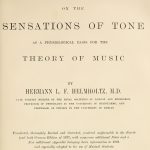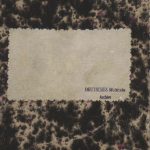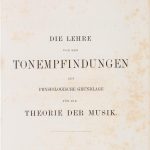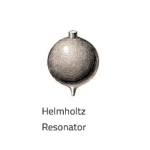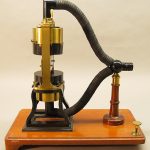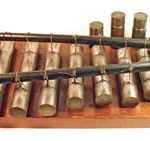Contributor Essays
Teaching Acoustics: Hermann von Helmholtz’s Lecture Notebooks
by Katharina Preller
February 8, 2019
For forty-five years, Hermann von Helmholtz taught physiology, anatomy, and physics at several universities. That included lectures on acoustics for physics students—a very different audience from the musicologists and musicians whom, among others, he had addressed in his most celebrated work, On the Sensations of Tone as a Physiological Basis for the Theory of Music. Five notebooks associated with Helmholtz’s lectures are preserved in the Deutsches Museum Archives: “Theoretical Physics” (NL 266/033), “Theory of Electricity and Magnetism” (NL 266/040), “Mathematical Acoustics” (NL 266/041), “Acoustics” (NL 266/043), and “General Physics” (NL 266/047). Because two of them deal specifically with acoustics, this essay reconstructs the range of topics and the role of scientific and musical instruments addressed in Helmholtz’s lectures on the science of sound.
Assuming that the five manuscripts were written in the context of Helmholtz’s lectures, they probably date from between 1871 and 1894, when Helmholtz was working at the University of Berlin. The seminar titles in the course catalogues correspond closely to all five notebooks. Helmholtz’s lectures at the chair of physiology in Heidelberg (1858–1871) did not deal with any of these subjects, even though most of his studies on acoustics were published at that time, including the famous On the Sensations of Tone.
In Berlin, Helmholtz covered musical acoustics in two lecture series: “Acoustics and the Physiological Theory of Music” (winter 1872/73) and “Physiological and Musical Acoustics” (winter 1874/75). He lectured on “Mathematical Acoustics” for the first time in summer 1875, then every two years in the summer semester. Acoustics was also included as one of many topics in the first part of his course on experimental physics, held every winter semester.
Depending on whether the two manuscripts were preparations for or transcripts of these lectures, either Helmholtz himself or his students may have been their authors. One student, Mihajlo Pupin, reported in his Reminiscences of Hermann von Helmholtz (1922): “Helmholtz never prepared his lectures on theoretical physics; he worked his subject out during the lecture and thus gave us students a chance to see the expression in that magnificent face when the mind of the master was in full action.” According to Pupin, then, Helmholtz generally spoke without notes when teaching, though given that the preserved notebooks cover various scientific fields, they may have served him as memory aids. In photos and paintings, Helmholtz is often depicted with notebooks in his hand or on a table (as in the two lead images above).
Surprisingly, the notebook “Mathematical Acoustics” bears the date “winter 1883/4” and the name “Culmann” on the inside cover.
![Fig. 1: “Mathematical Acoustics,” inside cover [p. 2]](https://soundandscience.net/wp-content/uploads/2023/02/Preller_fig3.png)
The lecture “Mathematical Acoustics” took place three times a week for one hour each. This may explain the length of the manuscript, which is 114 pages in octavo format. It contains mostly calculations and explanatory notes. Entries alternate in black and blue ink with many crossed-out sections. The contents have little in common with On the Sensations of Tone, but they are linked to some of Helmholtz’s other publications. For instance, next to the heading “Offenes Pfeiffenende” (“Mathematical Acoustics” [p. 47]) the notebook’s author gives a reference to Helmholtz’s “Theorie der Luftschwingungen in Röhren mit offenen Enden.” Apparently, this text provided further reading on the same subject.
The manuscript “Acoustics” originally had ninety-four pages; most of one sheet is ripped out (“Acoustics” [p. 43]). This notebook contains more drawings and fewer calculations than “Mathematical Acoustics.” Its overall structure closely parallels On the Sensations of Tone, which is divided into three main parts, “On the Composition of Vibrations,” “On the Interruptions of Harmony,” and “The Relationship of Musical Tones.”
The “Acoustics” notebook starts with eight paragraphs on basic terms and phenomena, defining sound, noise, tone, and timbre and introducing interference, beats, the composition of vibrations, and the theory of resonance. The following pages deal with the analysis of sounds, using resonators or by ear alone, corresponding to Chapters III and IV of Sensations of Tone. The notebook’s longest thematic section is on the movements of sound (“Schallbewegungen”). Similarly to Chapter V of Sensations of Tone, “On the Differences in the Quality of Musical Tones,” the notebook surveys the characteristics of sounds produced by musical instruments (when plucking, bowing, or striking strings or sounding bells, open and stopped pipes, reed pipes) and other sounding devices (cone-shaped tubes, hollow spheres, longitudinal and transversal vibrations of rods, tuning forks, plates). The focus then moves to the anatomy of the human vocal tract and ear. Helmholtz ends the first part of On the Sensations of Tone in the same manner.
As in the book’s second part, the notebook continues by examining “interruptions of harmony” from the perspective of science (combination tones, summation and difference tones, beats) and music (theory of consonances, dissonances, chords, suspensions, modulation). The last pages contain a summary (“Zusammenfassung,” in “Akustik” [pp. 45–46]). A “retrospect” also closes Part 2 of On the Sensations of Tone, but Part 3, on scales and tonality, is almost entirely missing in the notebook, which allocates only the two last pages to tempered scales. These topics were probably not relevant for the physics curriculum. Overall, the close structural correlation suggests that this notebook was designed as a paraphrase of the first two parts of On the Sensations of Tone.
A crucial aspect of Helmholtz’s work on sound is his use of instruments, both scientific and musical. As he wrote in the introduction to Sensations of Tone, “Personal observation is better than the exactest description, especially when, as here, the subject of investigation is an analysis of the sensations themselves, which are always extremely difficult to describe to those who have not experienced them.” Accordingly, his lectures taught sound analysis by means of resonators, but also by ear. Besides the resonators, sirens, and tuning forks, the notebook features a range of scientific apparatus, such as the Savart wheel, Scheibler tonometer, Appun sonometer, Lissajous microscope and Wheatstone instrument. Assistants may have helped Helmholtz operate these devices during lectures: Pupin describes how, in a lecture on theoretical physics, the “laboratory mechanician Noehde and Institute janitor Kabisch handled the apparatus and took most of the responsibility for their prompt operation. Helmholtz threw the searchlight of his giant intellect upon the hidden meaning of the experiments” (Reminiscences of Hermann von Helmholtz, 1922). As well as lecturing, Helmholtz conducted experiments in the physics laboratory, open for several hours a day from Monday to Saturday.
The facilities and instrument collection of the University of Berlin’s physics department were destroyed in a fire in 1945. This makes it difficult to know exactly what equipment was available to students, but clearly the use of scientific instruments was an integral part of teaching and learning acoustics at the university.


